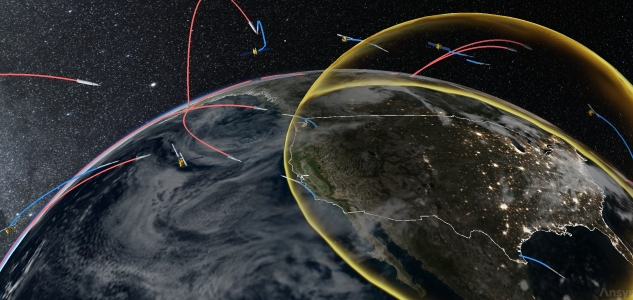Copyright Breaking Defense

Building a missile defense system the size and scope of the proposed Golden Dome initiative creates a number of challenges. In addition to the sheer size of the U.S., traditional missile-defense tactics will not be enough given the rise of recent threats such as advanced hypersonics and other sophisticated aerial threats. While traditional ICBMs have a defined trajectory and are a well-understood threat, the maneuverability and adaptability of hypersonics create new challenges that demand more and better sensors, more capable interceptors, and a robust and resilient communication network which can quickly adapt as new threats are identified. Breaking Defense spoke with Kevin Flood, president, Ansys Government Initiatives, to discuss Golden Dome, the challenges of missile defense and how simulation and open systems architecture can be used to develop, implement and update a missile defense system. Breaking Defense: We’re talking about missile defense in the U.S., which means we’re talking about Golden Dome. What are the fundamental challenges to building Golden Dome, and how are those challenges being defined and tackled? Flood: The challenges exist in multiple categories, but first and foremost is the scope and the scale of the system. When you look back over the history of the government and DoD, in particular, as projects get bigger, the risks go up, and success goes down. Earlier in my career, I was on the system integration and engineering team for the Strategic Defense Initiative (SDI) program in the early to mid-nineties. I got to see some of the challenges with a system that has a lot of similarities – a multilayered system, missile defense sensors and weapon systems in space, and some of the complexities related to that. The biggest thing is just the complexity of the system. Beyond that, the government has taken a position where we’re going to utilize the technologies that exist right now to address that. The next complexity beyond that is where those gaps exist. We know that we’ve got some sensor coverage challenges. We’d like to be in a better position with regard to the reliability and the performance of our interceptors. There’s infrastructure that needs to be in place for communications, command and control, battle management, those sorts of things. Those are the big challenges in front of us. Let’s talk more about the scale of the challenge. The obvious comparison here is Iron Dome, but comparing the size of the U.S. to Israel, we’re talking about a huge disparity. Also, Iron Dome is not designed for ICBMs. These aren’t challenges that scale up linearly, are they? No, not at all. Again, I go back to my SDI days where that was more of a consistent threat where we’re looking for long-range strategic weapons that could be largely anywhere on the globe. So, you need visibility to the entire globe. That means global sensor coverage. Right there, that’s a different scenario from what we have with Iron Dome largely deployed for the Israeli theater against much more tactical threats. That’s a completely different scenario. Additionally, with the emergence of advanced aerial threats, our timelines are very different from what at least the Iron Dome of today is designed to handle. That’s another threat scenario. The scale of the threat that we’re trying to address with Golden Dome is significantly different and requires a fundamentally different approach. There are some lessons to be learned probably from the Iron Dome system, which has proven largely effective, but I think the scale is different. The layered system we’re discussing, which includes weapons technology in space and many space-based sensors for global coverage, is another important component. The communications system that ties it all together operates on a completely different scale. All the detection, tracking, tipping, and cueing that must take place within multi-layered, low-latency air defense systems are critical for ensuring speed, reliability, and survivability. It is high complex and represents another level of sophistication beyond what we see with the Iron Dome. We’re trying to defend against unknown capabilities in a lot of ways. For example, hypersonics, we know what they can do, but we don’t know everything they can do. How do we prepare to defend against capabilities when we aren’t even quite sure what they are? I love that question, and this is where simulation becomes such an important component. When you run simulations at that level, one of the things you can do is test against a broad range of capabilities — both those that exist today and those you anticipate may emerge — to identify weak points and harden your system. You can then train the decision-making process, whether human, machine, or a combination of both, to respond to threats that have not yet evolved, with a human-in-the-loop or human-on-the-loop role ensuring the ability to monitor, guide, and intervene when necessary. One of the challenges, as we look back through our history, is that we’ve evolved a system requiring highly explicit definitions of requirements. The problem is that these systems often become mission-specific and are not designed from the ground up to adapt to new or changing circumstances. This architecture and mission set demand a different approach. Now is the time to think differently about system definition, moving away from rigid, point-in-time requirements toward architectures built for continuous adaptation. That shift also means understanding the current landscape of capabilities (i.e., what can be employed as-is, what can be upgraded to extend mission relevance, where entirely new systems must be developed to fill critical gaps). It’s not just about optimizing individual platforms, but about understanding the effectiveness of the entire system of systems and how each component contributes to overall mission readiness. What are the key distinctions between traditional design and testing methods and what we can do now with simulation? Number one, as is the case with today’s cyber-physical systems, the technology is far more integrated and advanced. Rather than focusing solely on physical models, modern approaches connect system architecture, mission context, and behavioral logic with high-fidelity physics so that we can assess how these elements operate together as one system. This allows us to understand not only how a system performs in isolation, but also how it behaves under mission-level conditions where software, hardware, and human or autonomous decision loops interact. With that integrated view, you can explore trade-offs across architecture, operational behaviors, and physical performance, refining your methods and directing resources toward what most advances the mission. You can test control strategies, see how software or logic shifts affect outcomes, and decide where to focus development for the greatest payoff. This is where simulation becomes a strategic advantage, Ansys Government Initiatives focuses on creating these advanced software tools for the defense industrial base. In essence, it brings design, behavior, and mission performance together in one view, helping teams make decisions from a system-level perspective rather than isolated data points. As threats evolve, Golden Dome will have to do likewise. What are your thoughts on this? It’s critical, and the key thing is committing to open interfaces and interoperability. The administration has likewise emphasized leveraging commercial capabilities to the fullest extent possible. Think back to the early days of the internet. It was a period of rapid evolution, when organizations released new technologies, published interface specifications through requests for comments, and invited industry participation. In parallel, new technologies were brought online, while the broader community helped establish standards as real-world performance revealed which innovations succeeded and which did not. If we’re going to leverage the best of commercial capabilities, we should follow the same principles. I’m excited about this approach for both hardware and software systems. When we deliver capabilities to the government or private industry and there’s a missing capability or they want to do something differently, we don’t have to reprogram our entire stack and wait multiple years for that capability to be delivered. This empowers our customers to adopt the latest technologies and transform a defensive position from reactive to proactive by turning innovation into an unconventional and disruptive advantage.



